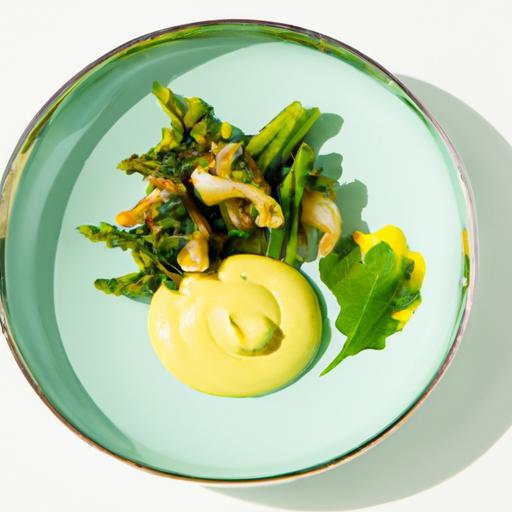From Ancient Seeds to Modern Tables: The History of Mustard
At first glance, mustard may seem like a humble condiment-just a splash of yellow on your sandwich or a tangy twist to your salad dressing. But delve deeper, and you’ll uncover a rich tapestry woven through millennia, cultures, and cuisines. From tiny seeds cultivated by ancient civilizations to the vibrant spoonful that graces contemporary plates worldwide, mustard’s journey is a fascinating tale of flavor, tradition, and innovation. This article explores the captivating history of mustard, tracing its roots from ancient fields to modern tables, revealing how this modest seed became a global culinary icon.
From Ancient Seeds to Modern Tables, mustard has woven its pungent, tangy essence through centuries of culinary and medicinal traditions. This captivating condiment, rooted in antiquity, carries flavors shaped by time and culture, elevating dishes from simple sandwiches to gourmet feasts. Embracing its rich heritage, this recipe spotlights a Mustard-Glazed Roast Chicken, a dish that honors mustard’s historical depth while delivering a modern palate-pleaser. The marriage of ancient seeds and contemporary flavors creates a succulent, golden-crisp bird glazed in a symphony of mustard varieties for complexity and depth.
Prep and Cook Time
- Preparation Time: 20 minutes
- Marinating Time: 1 hour (or overnight for best results)
- Cooking Time: 1 hour 15 minutes
Yield
- Serves 4 to 6
Difficulty Level
- Medium
Ingredients
- 1 whole chicken (about 4 lbs), patted dry
- 3 tbsp Dijon mustard (for a smooth, tangy base)
- 2 tbsp whole grain mustard (for texture and depth)
- 1 tbsp honey (to balance tanginess with mild sweetness)
- 3 cloves garlic, minced
- 2 tbsp olive oil (plus extra for drizzling)
- 1 tbsp fresh thyme, chopped
- 1 tsp smoked paprika
- Salt and freshly cracked black pepper, to taste
- Juice of 1 lemon
- Fresh rosemary sprigs, for roasting
Instructions
- Prepare the mustard glaze: In a small bowl, whisk together Dijon mustard, whole grain mustard, honey, minced garlic, olive oil, thyme, smoked paprika, lemon juice, salt, and pepper until smooth and well combined.
- Marinate the chicken: Carefully loosen the skin of the chicken breasts and thighs with your fingers and spread half of the mustard glaze underneath. Rub the remaining glaze all over the exterior of the chicken. Place the bird in a large bowl or resealable bag and refrigerate for at least 1 hour, preferably overnight to maximize flavor infusion.
- Preheat the oven: Set to 400°F (200°C). Arrange fresh rosemary sprigs in the bottom of a roasting pan to infuse aroma as the chicken cooks.
- Roast the chicken: Place the bird on top of the rosemary. Drizzle a little olive oil over the skin for extra crisping. Roast for 1 hour 15 minutes, or until the internal temperature reaches 165°F (75°C). Baste every 20 minutes with pan juices to keep the meat moist and flavorful.
- Rest and slice: Let the chicken rest for 10 minutes after roasting to allow juices to redistribute, ensuring tender, juicy meat.
- Serve: Carve and garnish with fresh thyme sprigs and a lemon wedge on the side for an optional fresh zing.
Chef’s Notes and Tips for Success
- Variations: Swap out Dijon for spicy brown mustard to add more heat, or experiment with adding a splash of apple cider vinegar to the glaze for tangy brightness.
- Make-ahead: Marinate overnight to deepen flavor, then roast just before serving.
- Roasting tips: For extra crisp skin, pat chicken dry before applying the glaze and ensure the oven is fully preheated.
- Substitutions: Use chicken thighs or legs if you prefer darker, juicier cuts.
- Leftover magic: Shred leftover chicken and toss with mayonnaise, celery, and a teaspoon of mustard for an irresistible sandwich filling.
Serving Suggestions
- Pair with a rustic roasted vegetable medley-think carrots, parsnips, and Brussels sprouts-to complement the mustard’s complexity.
- Serve alongside garlic mashed potatoes or creamy polenta for a comforting, complete meal.
- Garnish with fresh herbs like thyme or rosemary and a light drizzle of honey-mustard glaze to enhance visual appeal and flavor harmony.

| Nutrient | Amount per Serving |
|---|---|
| Calories | 350 kcal |
| Protein | 45 g |
| Carbohydrates | 4 g |
| Fat | 15 g |
Explore more ways to incorporate this timeless ingredient by visiting our Mustard Varieties and Uses post. For an authoritative dive into mustard’s botanical and medicinal history, check out Britannica’s Mustard Plant Overview.
Q&A
Q&A: From Ancient Seeds to Modern Tables – The History of Mustard
Q: What is the origin of mustard as a condiment?
A: Mustard’s story begins thousands of years ago in ancient civilizations. The earliest records trace mustard seeds back to the Indus Valley and Mesopotamia, where they were prized not only as a spice but also for their medicinal properties. From these fertile cradles of civilization, mustard seeds journeyed along trade routes, finding their way into Egyptian tombs and Greek banquets.
Q: How did mustard evolve from a simple seed into the sauces we enjoy today?
A: The transformation of mustard seeds into the tangy paste known worldwide started with the Romans. They mixed crushed mustard seeds with wine or vinegar, creating an early ancestor of our modern mustard sauce. As Europe embraced this vibrant mix, regional variations flourished – from the sharp Dijon mustards of France to the sweet and spicy versions popular in Germany.
Q: Why has mustard endured as a culinary favorite through the centuries?
A: Mustard’s enduring appeal lies in its bold versatility and the alchemy of its flavor – pungent yet nuanced, sharp yet balanced. It enhances meats, brightens sandwiches, and adds complexity to sauces. Beyond cooking, mustard was historically valued for health benefits, believed to stimulate digestion and alleviate ailments, cementing its place both at the table and in apothecaries.
Q: In what ways is mustard making a comeback in modern cuisine?
A: Today, chefs and food enthusiasts are rediscovering mustard’s potential, experimenting with heirloom seeds, artisanal blends, and innovative pairings. Mustard is no longer just a simple condiment; it’s a star ingredient in dressings, marinades, and even cocktails. Its rich history inspires a new wave of culinary creativity that honors tradition while pushing flavor boundaries.
Q: Can you share an interesting fact about mustard that most people might not know?
A: Certainly! The phrase “cut the mustard,” meaning to meet expectations, is believed to derive from the challenge of grinding tough mustard seeds to produce that perfect spicy punch. It’s a vivid reminder that mustard’s zest is not just in taste, but in the spirited effort behind creating it.
Q: How can someone incorporate mustard into their cooking to celebrate its heritage?
A: Embrace mustard’s diverse flavors by trying different types-yellow, brown, black, or whole grain. Use it as a marinade base for meats, a zesty addition to salad dressings, or simply spread it on a freshly baked loaf. Let mustard’s ancient roots and vibrant history inspire you to add a dash of boldness to your modern meals.
The Conclusion
As we trace mustard’s journey from ancient seeds carefully sown in early civilizations to its vibrant presence on modern tables worldwide, we uncover more than just a condiment – we discover a flavorful thread woven through history, culture, and cuisine. Each dollop carries whispers of time, from royal banquets and medicinal remedies to street food stalls and gourmet kitchens. Mustard’s enduring appeal lies not only in its bold taste but in its remarkable ability to adapt and inspire across millennia. So next time you savor that tangy kick, remember you’re tasting a story that began thousands of years ago, connecting past and present in a single, unforgettable bite.


